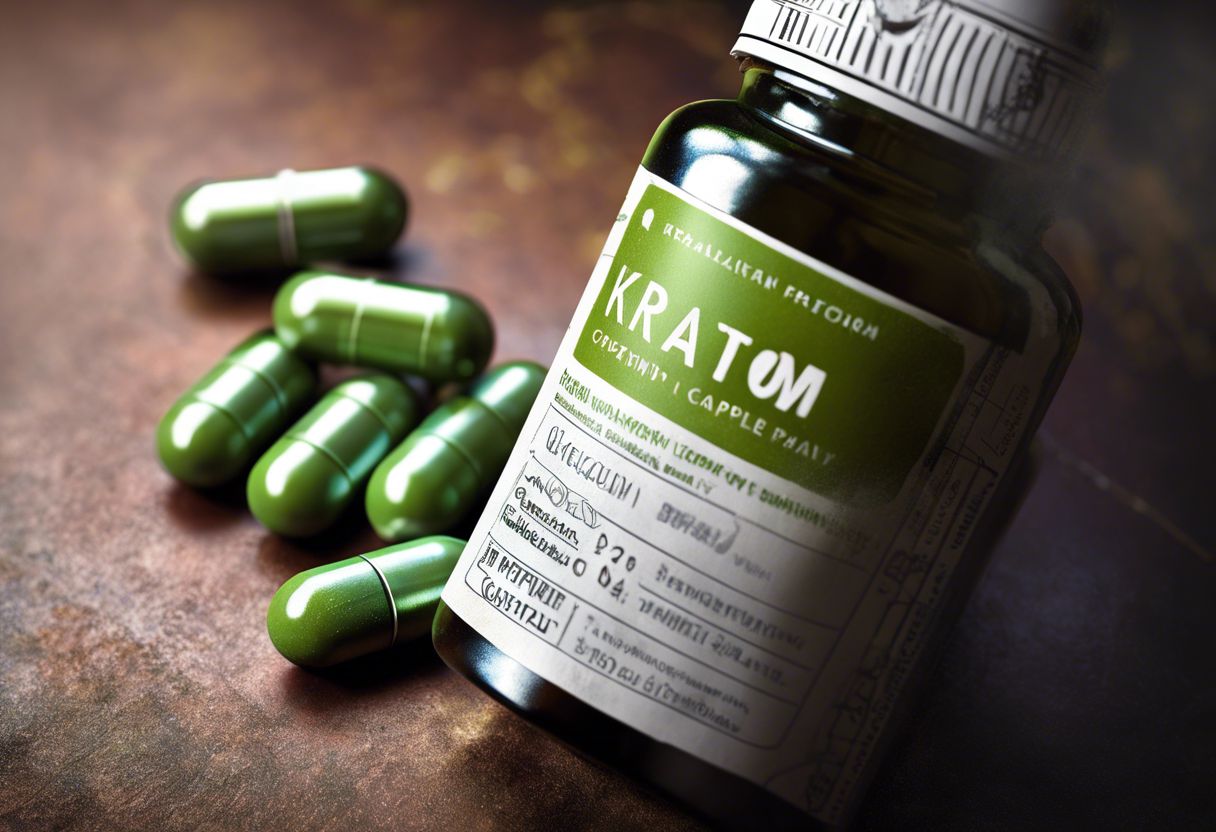Kratom has been making headlines as a natural remedy with the power to relieve pain and help with opioid withdrawal. With these promising benefits, it’s no surprise that you might be considering it as an option for managing discomfort or addiction issues.
But how safe is this herbal product? Many of you are searching for answers before taking the leap into adding kratom to your wellness routine.
In recent news, health authorities have raised red flags about kratom’s safety due to its similarity to opioids in both effects and risks. This blog post will guide you through what you need to know before using kratom.
From potential side effects and interactions with other drugs, we’ll explore the evidence so that you can make an informed decision. Let’s dive deeper into understanding whether kratom could be a helpful ally or a hidden hazard in your search for relief.
Keep reading; your well-being may depend on it.
Key Takeaways
- Kratom is like opioids and can cause addiction, overdose, and side effects such as weight loss, dry mouth, and nausea.
- Mixing kratom with other drugs or alcohol can be very dangerous. It’s not safe to mix them without talking to a doctor first.
- The FDA does not check kratom for safety like it does for medicine. So what’s in kratom can change a lot. This can make it risky to use.
- If you are addicted to kratom, there are treatments that can help. These include medical detox, therapy, support groups, and special medicines.
- Before using kratom, talk with a healthcare professional about the possible risks and how it might react with other things you use or eat.
Understanding Kratom

Kratom comes from the leaves of a tree in Southeast Asia and is part of the coffee family. People like it because it can ease pain, give energy, and make them feel good. But kratom acts like opioids too, so it has serious safety issues to think about.
It has substances called alkaloids that touch the same spots in your brain as some opioid drugs do. This can help with hurt or sadness but can also lead to addiction or overdose if not used carefully.
You need to know this before you decide if kratom is right for you. Next, let’s look at why people choose to use kratom despite these risks.
Why Do People Use Kratom?

After learning what kratom is, you might wonder why someone would choose to use it. People turn to kratom for several reasons. Some find it helps with pain, much like pain medicines do.
They may want natural relief and think kratom can offer that without the need for a doctor’s prescription. Others might use kratom because they are trying to stop using opioid drugs and don’t want the tough withdrawal symptoms.
Kratom can ease these symptoms because it works on some of the same spots in the brain as opioids.
Kratom also gives some people a mood boost or more energy. This makes them feel better if they are sad or tired. But it’s important to know that using kratom comes with risks and possible bad side effects.
It has things in common with opioid drugs, so there can be serious safety issues, just like there are with those medicines.
Potential Risks and Side Effects of Kratom
Kratom use can lead to a range of potential risks and side effects, including weight loss, dry mouth, nausea, constipation, dizziness, and even aggression. To learn more about the possible negative effects of kratom use, keep reading for further details.
Weight Loss
You might notice your weight drops if you take kratom. Your appetite can change, which may lead to eating less. But losing weight fast isn’t always safe or healthy. It could cause problems for your body if it happens because you’re not eating enough.
If weight loss is quick and unexplained, it’s important to talk to a doctor.
Next, some people feel their mouth gets very dry when they use kratom. This can be uncomfortable and make it hard to swallow or speak. Let’s look at why this happens and what you can do about it.
Dry Mouth
Kratom may cause dry mouth. This means your mouth feels dry and sticky due to reduced saliva production. Dry mouth can make it harder to speak, swallow, or even taste food. It’s an uncomfortable sensation that can also lead to bad breath and oral health issues if not managed properly.
Dry mouth is a common side effect of kratom use, which can be bothersome for many people. Taking regular sips of water or using sugar-free gum or candies can help alleviate this discomfort and keep your mouth moist.
It’s important to stay hydrated and practice good oral hygiene while using kratom to minimize the effects of dry mouth on your daily life.
Nausea
Nausea is a common side effect reported by some people who use kratom. It’s the feeling of wanting to vomit, which can be uncomfortable and unsettling. This sensation may occur shortly after consuming kratom and could impact your overall well-being.
Nausea is one of the potential risks associated with using kratom, and it’s essential to be aware of this possibility if you are considering its use.
Navigating potential side effects like nausea is crucial when exploring the use of kratom. Now, let’s delve into another aspect – Constipation – that you should consider before making a decision about using this herbal product.
Constipation
Kratom may cause constipation. This means it can make it hard for you to have a bowel movement. Constipation happens when your stool becomes difficult to pass and you might not go as often as usual.
It’s important to drink plenty of water and include fiber in your diet if you experience constipation while using kratom.
In addition, some people who use kratom find that they become constipated more frequently. Data shows that this is one of the potential side effects of taking kratom regularly, so it’s important to be aware of how your body reacts and take proper precautions.
Dizziness
Feeling lightheaded and unsteady after taking kratom may happen. Some people report dizziness as a potential side effect. It’s essential to be cautious and aware of how your body reacts when using kratom, especially if you experience dizziness, which can affect your daily activities.
While some individuals may not experience this symptom, it’s important to understand that dizziness is among the potential risks associated with kratom use. If you encounter this issue while using kratom, seeking guidance from healthcare professionals or considering alternative options could be crucial for your well-being in managing any adverse effects.
Aggression
Kratom use might lead to aggression. The substance can produce stimulant-like effects that may result in aggressive behavior. It is essential to be aware of this potential side effect and monitor your mood and behavior when using kratom.
Remember, monitoring your emotions and seeking help if you experience any concerning changes is important for your overall well-being as you explore the possible risks of kratom use.
Now, let’s delve into the dangers of kratom addiction.
The Dangers of Kratom Addiction
Kratom addiction can lead to serious health risks and withdrawal symptoms, including seizures, high blood pressure, and cravings. It’s important to be aware of the potential dangers and seek professional help if you or someone you know is struggling with kratom addiction.
Signs of Overdose
An overdose of kratom may lead to serious health issues, so it’s important to recognize the signs. Here are the potential indicators of a kratom overdose:
- Seizures: Kratom overdoses can trigger seizures, putting your health at risk.
- High blood pressure: Overdosing on kratom may cause a dangerous spike in blood pressure.
- Vomiting: Excessive use of kratom can lead to persistent vomiting, which can be harmful.
- Nervousness: Overdosing may result in heightened nervousness and anxiety, affecting your well-being.
- Aggression: In extreme cases, an overdose might lead to increased aggression and irritability.
Withdrawal Symptoms
After recognizing the signs of overdose, it’s important to be aware of the potential withdrawal symptoms associated with kratom use. Here are some common withdrawal symptoms that individuals may experience when stopping or reducing kratom intake:
- Anxiety: Many individuals may experience increased anxiety levels, which can lead to feelings of restlessness and unease.
- Insomnia: Difficulty falling asleep or staying asleep is a frequent withdrawal symptom associated with kratom cessation.
- Muscle aches: Withdrawal from kratom may cause muscle aches and discomfort throughout the body.
- Irritability: Sudden changes in mood, including heightened irritability and agitation, are commonly observed during kratom withdrawal.
- Runny nose: Some individuals may experience flu-like symptoms such as a runny or stuffy nose during withdrawal from kratom.
- Tremors: Unintentional trembling or shaking of hands and limbs can occur as part of kratom withdrawal syndrome.
- Sweating: Excessive sweating beyond what is typical for an individual could be experienced during kratom cessation.
- Nausea and vomiting: Gastrointestinal distress, including nausea and vomiting, is another potential withdrawal symptom associated with discontinuing kratom use.
- Depressed mood: A sudden decrease in overall mood well-being or feelings of depression can manifest during kratom withdrawal.
- Drug craving: Strong urges or intense cravings for kratom may persist during the initial period of cessation.
The Lack of Regulation for Kratom
Kratom is not regulated by the FDA like prescription drugs. This means that there are no set standards for its production and distribution, potentially leading to variations in quality and safety.
The lack of regulation also makes it challenging to monitor the purity and potency of kratom products available in the market.
Furthermore, without regulatory oversight, there is a risk of contamination with heavy metals or other harmful substances, which could pose health hazards to consumers. Lack of regulation can also result in inconsistent labeling practices, making it difficult for buyers to know exactly what they are getting.
These aspects highlight the need for thorough research and caution when considering kratom use due to these unaddressed safety concerns.
Mixing Kratom with Other Substances
Mixing Kratom with other substances, such as alcohol or sedative medications, can have dangerous and potentially life-threatening effects. It’s important to be aware of these risks and avoid combining Kratom with any other substances without consulting a healthcare professional.
Kratom and Alcohol
Using kratom and alcohol together can be very dangerous. Both substances depress the central nervous system, affecting your breathing and heart rate. This increases the risk of overdose, coma, or even death.
Drinking alcohol while using kratom can also worsen the side effects of both substances like nausea, dizziness, and impaired motor function.
Combining kratom with alcohol may also increase the risk of developing liver problems as both are metabolized in the liver. Moreover, since both substances can cause dehydration, using them together may lead to severe dehydration and other health complications.
Special Precautions and Warnings about Kratom Use
It’s essential to be cautious when using Kratom, as it can interact with certain medications and substances. Ensure you are aware of potential interactions with Modafinil (Provigil), CNS depressants, Naltrexone (Vivitrol), Venlafaxine (Effexor), and various liver-metabolized medications.
Always consult a healthcare professional before using Kratom in combination with any other medication or supplement.
Interactions with Modafinil (Provigil)
Modafinil, also known as Provigil, is a medication used to promote wakefulness in individuals with certain sleep disorders. When combined with kratom, Modafinil can cause adverse interactions.
It’s essential to be cautious about mixing these substances because it may lead to unpredictable effects and potential health risks. Kratom’s stimulating properties coupled with Modafinil’s impact on the central nervous system can result in intensified side effects like increased heart rate or high blood pressure, posing serious dangers.
Kratom’s potential for abuse and addiction may also be heightened when taken alongside Modafinil. This combination could amplify the risk of dependency and withdrawal symptoms. Because both substances affect brain chemistry similarly, their interaction might lead to an increased likelihood of developing harmful patterns of use.
Interactions with Medications Changed by the Liver (Cytochrome P450 3A4 (CYP3A4) substrates)
You should know that Kratom can interact with medications changed by the liver, specifically those metabolized by Cytochrome P450 3A4 (CYP3A4) substrates. This interaction has the potential to alter how these medications work in your body, possibly leading to harmful effects or reduced effectiveness.
It’s important to be cautious when using Kratom alongside any medications that are processed through this liver enzyme pathway.
Kratom’s interaction with drugs affected by Cytochrome P450 3A4 (CYP3A4) substrates could result in unexpected side effects or adverse reactions due to changes in medication metabolism.
Interactions with Medications Changed by the Liver (Cytochrome P450 2D6 (CYP2D6) substrates)
Kratom might interact with medications that are changed by the liver, like fluoxetine and paroxetine. This could make these medications less effective in your body. Be cautious if you take any of these medicines along with kratom, as it may lead to unexpected effects or reduced efficacy.
Always talk to your doctor before using kratom if you’re taking any medications metabolized by CYP2D6 enzymes to ensure your safety.
Remember that mixing kratom with certain medications can be risky, so seek professional advice before combining them. It’s essential to understand how kratom may interact with other substances to avoid potential harm and ensure the effectiveness of your medication regimen.
Interactions with Medications Changed by the Liver (Cytochrome P450 1A2 (CYP1A2) substrates)
When using Kratom, be cautious if you take medications metabolized by the liver through a pathway called Cytochrome P450 1A2 (CYP1A2). These include drugs like propranolol for high blood pressure, theophylline for asthma, and clozapine for schizophrenia.
Kratom might affect how your body processes these medications, leading to potential side effects or reduced effectiveness. It’s important to consult with a healthcare professional before combining Kratom with any medication metabolized by CYP1A2 substrates to avoid adverse interactions and ensure your safety.
Considering that Kratom can impact the way certain medications work in your body, it’s crucial to inform your doctor about your Kratom use if they prescribe any of these drugs. This will help them adjust dosages or choose alternative medications as necessary to prevent any harmful effects from occurring.
Interactions with Sedative Medications (CNS depressants)
Interactions between kratom and sedative medications, also known as CNS depressants, can be risky. It’s important to understand that combining these substances can lead to extreme drowsiness, difficulty breathing, and even unconsciousness.
Kratom has effects similar to opioids, so mixing it with sedatives can intensify these effects and may result in serious health complications or overdose. Always consult a healthcare professional before using kratom if you’re taking any sedative medications to ensure your safety.
Keep in mind that blending kratom with CNS depressants such as benzodiazepines or sleep aids can amplify the central nervous system’s depression. This interaction could lead to slowed heart rate and breathing which are dangerous symptoms of an overdose.
Interactions with Naltrexone (Vivitrol)
After understanding the potential interactions between kratom and sedative medications, it’s essential to consider how kratom may interact with Naltrexone (Vivitrol). Naltrexone is used to treat opioid addiction by blocking the effects of opioids.
When taken with kratom, an herbal product known for opioid-like effects, it can lead to conflicting actions in the body. Since both substances impact opioid receptors, their combined use may diminish the effectiveness of each other or even cause adverse reactions.
Considering these interactions is crucial in making informed decisions about using kratom while on Naltrexone therapy.
Using both kratom and Naltrexone simultaneously carries risks due to their potential counteracting effects on opioid receptors. This interaction could compromise the intended therapeutic benefits of Naltrexone treatment and possibly result in unpredictable outcomes that may pose dangers to your well-being.
Interactions with Venlafaxine (Effexor)
Venlafaxine (Effexor), a medication for depression and anxiety, can interact with kratom. Using both together may increase the risk of side effects such as dizziness, drowsiness, and difficulty concentrating.
It’s crucial to avoid combining venlafaxine with kratom unless specifically advised by your healthcare provider. Additionally, using them together might also affect how your body processes each substance, leading to potential health risks and complications.
Be sure to consult your doctor before using venlafaxine or any other medications alongside kratom.
By understanding these interactions and seeking professional advice, you can make informed decisions about using kratom while taking venlafaxine (Effexor) or any other medications for depression and anxiety.
FDA Warnings on Kratom Use
The FDA has issued warnings about the potential dangers of using Kratom. Here are important points to consider:.
– The FDA warns that Kratom can have opioid-like properties and may pose risks similar to those associated with opioids.
– Numerous cases have emerged where kratom is contaminated with salmonella, potentially leading to severe infections.
Consequently, it is essential for consumers shopping for Kratom online to stay informed about these warnings before use.
Treatment for Kratom Addiction
After understanding the potential risks and FDA warnings on Kratom use, it’s important to be aware of the available treatment options for Kratom addiction. If you or someone you know is struggling with Kratom addiction, here are some treatment approaches that could help:.
1. Medical Detoxification: Seek professional medical assistance for a supervised detox process to manage withdrawal symptoms safely.
2. Behavioral Therapy: Engage in cognitive-behavioral therapy (CBT) or contingency management interventions tailored to address addictive behaviors and promote long-term recovery.
3. Support Groups: Consider joining support groups such as Narcotics Anonymous (NA) or seeking counseling services to connect with individuals facing similar challenges and receive guidance throughout the recovery journey.
4. Medication-Assisted Treatment (MAT): Explore MAT programs involving medications like buprenorphine to alleviate cravings and restore balance while undergoing behavioral therapies.
5. Holistic Approaches: Embrace holistic methods including mindfulness practices, yoga, and acupuncture to enhance overall well-being during recovery.
6. Individualized Treatment Plans: Work with healthcare professionals to develop personalized treatment plans addressing specific needs and factors contributing to addiction.
7. Inpatient Rehabilitation: Consider inpatient rehabilitation programs offering intensive care, structure, and therapeutic activities within a supportive environment.
Conclusion
In conclusion, using kratom may come with risks and potential side effects. It can interact with other substances, leading to harmful effects and overdose. Despite pain-relieving properties similar to opioid drugs, its safety remains a topic of debate within the medical community.
Therefore, it’s crucial to be aware of the potential dangers and exercise caution while considering kratom use. Always consult a healthcare professional for personalized guidance on using this herbal product safely.
For a deeper dive into the specific risks of combining kratom and alcohol, read our detailed article “Kratom and Alcohol: Understanding the Risks and Interactions.”
FAQs
1. What is Kratom and why do people use it?
Kratom comes from a plant called Mitragyna speciosa. Some take it for pain relief, energy boosting, or to feel relaxed.
2. Has the FDA said anything about Kratom?
Yes, the U.S. Food and Drug Administration (FDA) has warned that Kratom can be dangerous and may cause harm like addiction or even make people sick with salmonella.
3. Can you get addicted to Kratom?
Yes, using too much Kratom can lead to addiction just like other drugs such as opioids.
4. Are there any side effects from taking Kratom?
Yes, taking kratom might give some people a headache or make them feel sick to their stomachs. Other times it might make someone hurt if they stop taking it after using a lot.
5. Is it legal to buy and sell Kratom in the United States?
The rules are different in each place; some parts of the country say no while others let you buy and sell without trouble.
6. Should I talk to my doctor before trying Kratom for health issues?
Absolutely! Always chat with your doctor first because they know what’s safe and can help guide you away from risky stuff.






